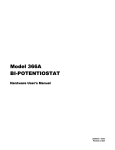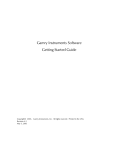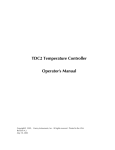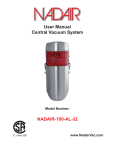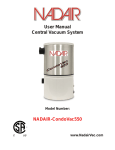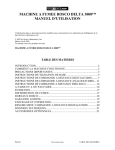Download Impedance Scanning Quartz Crystal Microbalance Operators Manual
Transcript
TM Impedance Scanning Electrochemical Quartz Crystal Microbalance i ii Impedance Scanning Electrochemical Quartz Crystal Microbalance Operator's Manual Copyright 2012 Gamry Instruments, Inc. Revision 1.2 August 27, 2012 iii If You Have Problems Please visit our service and support page at www.gamry.com/service-support/. This page contains information on installation, software updates, and training. It also contains links to the latest available documentation. If you are unable to locate the information you need from our website, you can contact us via email using the link provided on our website. Alternatively, you can contact us one of the following ways: Internet www.gamry.com/service-support/ Telephone (215) 682-9330 9:00 AM - 5:00 PM US Eastern Standard Time (877) 367-4267 Toll Free US & Canada Only Please have your instrument model and serial numbers available, as well as any applicable software and firmware revisions. If you have problems in installation or use of a system containing an eQCM10M, it would be helpful if you called from a phone next to your computer, where you can type and read the screen while talking to us. We will be happy to provide a reasonable level of free support for registered users of the eQCM10M. Reasonable support includes telephone assistance covering the normal installation, use and simple customization of a computerized system containing an eQCM10M connected to a Windows compatible computer. A service contract that extends both the hardware warranty and software update period is available at an additional charge. Software updates do not include software enhancements offered to our customers at additional cost. Enhancements to the eQCM10M and Gamry’s standard applications software that require significant engineering time on our part can be performed on a contract basis. Contact us with your requirements. iv Limited Warranty Gamry Instruments, Inc. warrants to the original user of this product that it shall be free of defects resulting from faulty manufacture of the product or its components for a period of two years from the original shipment date of your purchase. Gamry Instruments, Inc. makes no warranties regarding either the satisfactory performance of the eQCM 10M including the software provided with this product or the fitness of the product for any particular purpose. The remedy for breach of this Limited Warranty shall be limited solely to repair or replacement, as determined by Gamry Instruments, Inc., and shall not include other damages. Gamry Instruments, Inc. reserves the right to make revisions to the system at any time without incurring any obligation to install same on systems previously purchased. All system specifications are subject to change without notice. There are no warranties which extend beyond the description herein. This warranty is in lieu of, and excludes any and all other warranties or representations, expressed, implied or statutory, including merchantability and fitness, as well as any and all other obligations or liabilities of Gamry Instruments, Inc; including but not limited to, special or consequential damages. This Limited Warranty gives you specific legal rights and you may have others, which vary from state to state. Some states do not allow for the exclusion of incidental or consequential damages. No person, firm or corporation is authorized to assume for Gamry Instruments, Inc., any additional obligation or liability not expressly provided herein except in writing duly executed by an officer of Gamry Instruments, Inc. v Disclaimers Gamry Instruments, Inc. cannot guarantee that the eQCM 10M will work with all computer systems, operating systems, and third party software applications hardware/software. The information in this manual has been carefully checked and is believed to be accurate as of the time of printing. However, Gamry Instruments, Inc. assumes no responsibility for errors that might appear. Copyrights eQCM 10M™ Impedance Scanning Electrochemical Quartz Crystal Microbalance Operator's Manual copyright 2012, Gamry Instruments, Inc., all rights reserved. Gamry Framework - copyright 1989-2012, Gamry Instruments, Inc., all rights reserved. Reference 600, Reference 3000TM, PC4, PCI4, eQCM 10M, Gamry Framework, PHE200, and Gamry are trademarks of Gamry Instruments, Inc. No part of this document may be copied or reproduced in any form without the prior written consent of Gamry Instruments, Inc. vi Table of Contents Limited Warranty ...........................................................................................................................v Disclaimers ....................................................................................................................................vi Copyrights .....................................................................................................................................vi Chapter 1 -- Safety Considerations ................................................................................................1-1 Inspection.........................................................................................................................1-1 Product Safety ..................................................................................................................1-1 AC Mains Connection to the Power Brick ..........................................................................1-1 Grounding in the eQCM 10M ...........................................................................................1-2 Temperature and Ventilation.............................................................................................1-2 Defects and Abnormal Stresses ..........................................................................................1-3 Environmental Limits.........................................................................................................1-3 Cleaning ...........................................................................................................................1-3 Service..............................................................................................................................1-3 Emission Warning .............................................................................................................1-4 Electrical Transient Sensitivity ............................................................................................1-4 CE Compliance .................................................................................................................1-4 RoHS Compliance.............................................................................................................1-4 Chapter 2 -- Introduction ..............................................................................................................2-1 About this Manual.............................................................................................................2-1 About the eQCM 10M ......................................................................................................2-1 Notational Conventions.....................................................................................................2-1 Chapter 3 -- Instrument Circuitry...................................................................................................3-1 eQCM 10M Schematic/Block Diagram ..............................................................................3-1 Chapter 4 -- Installation ................................................................................................................4-1 Initial Visual Inspection .....................................................................................................4-1 Physical Location ..............................................................................................................4-2 Computer Requirements ...................................................................................................4-2 Plug & Play System Configuration......................................................................................4-2 Power Cord and Power Connection ..................................................................................4-3 Power Up Test ..................................................................................................................4-3 USB Cabling .....................................................................................................................4-4 1st Time Device Installation in Windows ............................................................................4-5 Device Manager................................................................................................................4-7 Chapter 5 -- Cell Connections .......................................................................................................5-1 Normal Cell Connections ..................................................................................................5-1 Quartz Crystal Installation .................................................................................................5-2 Chapter 6 -- Panel Indicators and Connectors................................................................................6-1 Front Panel .......................................................................................................................6-1 Quartz Crystal Holder Connector .........................................................................6-1 The Power LED....................................................................................................6-1 The Data LED ......................................................................................................6-1 Rear Panel ........................................................................................................................6-1 Power In Jack.......................................................................................................6-1 Power Switch.......................................................................................................6-1 Chassis Ground....................................................................................................6-2 USB Port..............................................................................................................6-2 Appendix A – eQCM 10M Specifications........................................................................................6-3 Appendix B – CE Certificate ...........................................................................................................6-4 Declaration of Conformity.................................................................................................6-4 Comprehensive Index ....................................................................................................................7-1 Chapter 1 -- Safety Considerations--Inspection Chapter 1 -- Safety Considerations Your eQCM 10M has been supplied in a safe condition. This chapter of the eQCM 10M Operator's Manual contains some information and warnings that you must follow to insure continued safe operation of the eQCM 10M. Inspection When you receive your eQCM 10M Impedance Scanning Electrochemical Quartz Crystal Microbalance you should inspect it for evidence of shipping damage. If any damage is noted, please notify Gamry Instruments Inc. and the shipping carrier immediately. Save the shipping container for possible inspection by the carrier. WARNING An eQCM 10M that has been damaged in shipment can be a safety hazard. Do not operate damaged apparatus until a qualified service technician has verified its safety. Tag a damaged eQCM 10M to indicate that it could be a safety hazard. Product Safety The eQCM 10M has been designed, tested and certified to meet the requirements of EN 61010, Safety requirements for electrical equipment for measurement, control, and laboratory use. As defined in this standard, it is a Category I apparatus, designed for connection to circuits other than the power mains. The instrument contains a limited amount of internal circuitry that is at “hazardous live” voltages as defined in EN 61010 (the standard mentioned above). “Reinforced insulation” (again defined in EN 61010) is used to reduce the risk of electrical shock due to this “hazardous live” voltage. As a generalization, input and output voltages in the eQCM 10M are limited to 12 volts. This voltage level is considered safe. The “AC Adapter” supplied with the instrument is certified under EN 60950. The AC Adapter converts the AC mains voltage to 12 volts DC, which is used to power the instrument. You should always use the AC adapter (power brick) supplied with your eQCM 10M to supply DC power to the instrument. Warning Do not use a DC power source other than the AC adapter model provided with your eQCM 10M. Other replacements may void the performance and/or safety characteristics of the eQCM 10M. AC Mains Connection to the Power Brick The eQCM 10M does not connect directly to an AC Mains supply. Instead, the mains are connected to a desktop AC adapter (power brick), which outputs 12 volts DC, which in turn powers the instrument. NOTE The instrument’s AC Adapter is rated for operation from 100 to 240 volts AC, 50 to 60 Hz. It should therefore be useful throughout the world. 1-1 Chapter 1 -- Safety Considerations--Grounding in the eQCM 10M The instrument is normally provided with an AC line cord suitable for your location. This AC line cord connects the AC mains to the AC power adapter. If your instrument has been provided without an AC line cord, or a cord that is not compatible with your local AC mains socket, obtain a line cord certified for use in your country. Contact your local Gamry Representative or Email to [email protected] if you are uncertain what AC line cord to use. Grounding in the eQCM 10M A Chassis Ground binding post on the rear panel of the eQCM 10M is provided for a connection to earth ground. Simply run a wire from this binding post to a suitable source of earth ground. A black 1.2-meter wire is provided to facilitate this connection. NOTE Sources of earth ground include; • Most metal water pipes, • the chassis of most electronic apparatus (which are generally earth grounded), and • the protective ground terminal of an AC Mains power plug. We recommend that you discuss grounding with an electrical or electronics professional prior to making this earth ground connection. Note this connection of the instrument to an earth ground is not a “Protective Earth Ground” as defined in EN 61010. This binding post is not intended for any use other than connecting the eQCM 10M to an earth ground to improve shielding against noise. Connecting this binding post to a hazardous voltage can create a significant safety hazard. WARNING Do not connect the chassis ground binding post to any voltage other than earth ground. An improper connection can create a safety hazard, which could result in personal injury or death. Temperature and Ventilation Your eQCM 10M Impedance Scanning Electrochemical Quartz Crystal Microbalance was designed for indoor use at ambient temperatures between 0°C and 45°C. Caution Do not block the airflow around the instrument chassis. While the circuitry should suffer no damage due to excessive heat, the enclosure may become uncomfortably hot to the touch with insufficient air flow aorund the chassis. Be careful when operating the instrument in an enclosed space (such as an enclosed relay rack or NEMA enclosure). The temperature within the enclosure must not exceed 45°C. You may need to provide ventilation holes or even forced air-cooling for the enclosed space if excessive temperature rise occurs. 1-2 Chapter 1 -- Safety Considerations--Defects and Abnormal Stresses Defects and Abnormal Stresses You should treat your eQCM 10M as potentially hazardous if any of the following is true of the unit: • it shows visible damage, • it does not operate properly, • it has been stored for a long period of time under unfavorable conditions, • it has been dropped or subjected to severe transport stress, • it has been subjected to environmental stress (corrosive atmosphere, fire, etc.). Do not use your eQCM 10M or any other apparatus if you think it could be hazardous. Have it checked by qualified service personnel. Environmental Limits Note that there are environmental limits conditions on the storage, shipping and operation of this equipment. The eQCM 10M has not been designed for outdoor use. Storage Ambient Temperature Relative Humidity -40 °C to 75 °C Maximum 90% non-condensing Shipping Same as storage plus Acceleration Maximum 30 G Operation Ambient Temperature Relative Humidity 0 °C to 45 °C Maximum 90% non-condensing Warning The instrument is not designed for operation in conditions where liquid water may enter the chassis, or water vapor may condense within the chassis. Operation of an instrument that has water within the chassis can create a safety hazard, which could result in personal injury or death. Cleaning Disconnect the eQCM 10M from all power sources prior to cleaning. Use a cloth lightly dampened with either clean water or water containing a mild detergent to clean the outside of the enclosure. Alternatively, you can use isopropyl alcohol. Do not use a wet rag or allow fluid to enter the enclosure. Do not immerse the instrument in any type of cleaning fluid (including water). Do not use any abrasive cleaners. Service Your eQCM 10M Impedance Scanning Electrochemical Quartz Crystal Microbalance has no user serviceable parts inside. You should refer all service to a qualified service technician. Warning The eQCM 10M must not be operated with any cover or panel on the chassis open. Dangerous voltages may present at several points within the instrument chassis, including PC board traces. Always remove the power connection before opening the case. 1-3 Chapter 1 -- Safety Considerations--Emission Warning Emission Warning Your eQCM 10M Impedance Scanning Electrochemical Quartz Crystal Microbalance generates, uses, and can radiate radio frequency energy. The radiated levels are low enough that the instrument should not create an interference problem in most industrial laboratory environments. The eQCM 10M has been tested for both radiated and conducted RF interference and has been found to be in compliance with EN 50081-1, 55011, and 55022 and 61000-4-3. Electrical Transient Sensitivity Your eQCM 10M Impedance Scanning Electrochemical Quartz Crystal Microbalance was designed to offer reasonable immunity from electrical transients, including transients on the incoming AC Mains supply and Electrostatic Discharge. It has been tested for compliance with EN 580082-2, 61010-1, and EN 61010-2-081. The eQCM 10M is not rated for continuous use when subject to ESD events. It should suffer no permanent damage when subject to the standard ESD events defined in EN61000-4-2, but may cease normal operation until it is powered down and restarted. In severe cases, the instrument could malfunction as a result of electrical transients such as a static discharge. If you are having problems in this regard, the following steps may help: If the problem is static electricity (sparks are apparent when you touch the instrument or it’s cables): • Placing the instrument on a static control work surface may help. Static control work surfaces are now generally available from computer supply houses and electronics tool suppliers. An antistatic floor mat may also help, particularly if a carpet is involved in generating the static electricity. • Air ionizers or even simple air humidifiers can reduce the voltage available in static discharges. If the problem is AC power line transients (often from large electrical motors near the instrument): • Try plugging your eQCM 10M into a different AC power branch circuit. • Plug your eQCM 10M into a power line surge suppressor. Inexpensive surge suppressors are now generally available because of their use with computer equipment. Contact Gamry Instruments, Inc. if these measures do not solve the problem. CE Compliance The European Community has instituted standards limiting radio frequency interference emitted by electronic devices, setting limits for susceptibility of apparatus to RF energy and transient events, and mandating safety requirements. The eQCM 10M Impedance Scanning Electrochemical Quartz Crystal Microbalance has been tested to comply with these standards. The relevant CE regulations include EN 61010 and EN 61326. RoHS Compliance The eQCM 10M Impedance Scanning Electrochemical Quartz Crystal Microbalance has been built using lead free components and lead free solder. It is in compliance with the European RoHS initiative. 1-4 Chapter 2 -- Introduction--About this Manual Chapter 2 -- Introduction About this Manual This manual covers the installation, safety, and use of the eQCM 10M Impedance Scanning Electrochemical Quartz Crystal Microbalance. This manual describes use of an eQCM 10M with Revision 5.62 (and later revisions) of the Gamry Resonator software. Chapter 1 was an in-depth discussion of safety issues. This chapter describes this manual and gives a brief overview of the eQCM 10M features. Chapter 3 is a description of the electronics circuitry in the eQCM 10M. Chapter 4 contains installation instructions. Chapter 5 describes inserting a crystal into a holder and connecting the holder to the eQCM 10M and Chapter 6 describes the eQCM 10M’s Front and Rear Panels. You will find specifications in the Appendix. This manual does not discuss software installation or software operation in any detail. Software support for the eQCM 10M is described in the Gamry’s On-line Help system and associated documentation. About the eQCM 10M The eQCM 10M is a research grade electrochemical instrument packaged in a small, easy to handle case. It offers measurement capabilities similar to instruments that are more than ten times its size and weight and more than two times its price. The instrument can operate as a stand-alone quartz crystal microbalance or in conjunction with a potentiostat. eQCM 10M features include: • 1 – 10 MHz operating range with no need to send the unit back to the factory in order to recalibrate for different frequency crystals • DC-decoupled output for interface with a potentiostat • 0.02 Hz resolution • Reporting of both the series and parallel resonance frequencies • An insulated USB connection avoiding ground loops The eQCM 10M, like all Gamry instruments, requires a computer for its use. Unlike some other quartz crystal microbalances, the instrument interfaces to the computer through a USB connection. The USB connection has become truly universal, with USB ports found on all modern computers. Notational Conventions In order to make this manual more readable we have adopted some notational conventions. These are used throughout this manual and all other Gamry Instruments manuals: • Numbered lists. A numbered list is reserved for step-by-step procedures, with the steps always performed sequentially. • Bulleted list. The items in a bulleted list, such as this one, are grouped together because they represent similar items. The order of items in the list is not critical. • File names and folders. Inside paragraphs, references to computer files and Windows folders will be capitalized and placed within quotes, for example: “C:\MYGAMRYDATA\EQCM.DTA" and “GAMRY5.INI". 2-1 Chapter 2 -- Introduction--Notational Conventions 2-2 Chapter 3 -- Instrument Circuitry--eQCM 10M Schematic/Block Diagram Chapter 3 -- Instrument Circuitry eQCM 10M Schematic/Block Diagram If you are not familiar with electronic schematics or quartz crystal microbalances, you probably want to skip this chapter. This information is for expert use only and is not required for routine use of the instrument. The following figure is part schematic diagram and part block diagram. They are intended to show the basic principles of the instrument without the confusion of the full circuitry details. The schematic/block diagram figure shows the quartz crystal microbalance board. Figure 3-1 eQCM 10M Impedance Scanning Quartz Crystal Microbalance Board Simplified Schematic/Block Diagram Notes for Figure 3-1 • The programmable logic device (PLD) acts as the core of the QCM. Sine waves of varying frequencies and amplitude are generated by the DDS, in 4096 steps from 0.05 to 8.33 Vrms. The PLD and DDS are driven by the same primary 80 MHz clock (CLK). • Output from the DDS is filtered through a 4th order low-pass filter (LP) with a cut-off range of 15 MHz. This signal is amplified by a high-speed current-feedback operational amplifier. The amplified signal is passed through the AC coupler (AC cpl.) and injected into the quartz crystal. 3-1 3-3 Chapter 3 -- Instrument Circuitry--eQCM 10M Schematic/Block Diagram • The coupler allows integration to a potentiostat for electrochemical studies. The output signal from the crystal is coupled out by the same network. The signal is then passed through an RMS-to-DC (TRMS) converter and evaluated by a successive approximation A/D-converter (ADC). • The PLD then performs some low-level math functions and delivers the data to a ground-isolated (ISO), USB interface (USB). 33--42 Chapter 4 -- Installation--Initial Visual Inspection Chapter 4 -- Installation This chapter of the Gamry Instruments Inc. eQCM 10M Operator's Manual covers normal installation of the instrument. Figure 4 - 1 View of an eQCM 10M Initial Visual Inspection After you remove your eQCM 10M from its shipping carton, you should check it for any signs of shipping damage. If any damage is noted, please notify Gamry Instruments, Inc. and the shipping carrier immediately. Save the shipping container for possible inspection by the carrier. Warning The “reinforced insulation” that keeps the operator from accessing the “hazardous live” voltages in the instrument can be rendered ineffective if the eQCM 10M is damaged in shipment. Do not operate damaged apparatus until a qualified service technician has verified its safety. Tag a damaged eQCM 10M to indicate that it could be a safety hazard. Warning If the eQCM 10M is taken from a cold location (for example outdoors in winter conditions) to a warm humid location, water vapor could condense on the cold surfaces inside the instrument, possibly creating a hazardous condition. Before connecting power to a “cold” eQCM 10M, allow at least one hour for the instrument to warm at room temperature. 4-1 Chapter 4 -- Installation--Physical Location Physical Location You normally locate your eQCM 10M on a flat workbench surface. You will want to have access to the rear of the instrument because some cable connections are made from the rear. The eQCM 10M is generally operated in a horizontal position (see Figure 4-1). Operation in other positions is possible as long as you insure that air movement around the chassis is not restricted. Caution Do not block the airflow around the chassis. While the circuitry should suffer no damage due to excessive heat, the enclosure may become uncomfortably hot to the touch if no air flows around the chassis. Running the instrument without adequate cooling could shorten the time to failure of some of the circuitry. If you do place your eQCM 10M within an enclosed space, make sure that the internal temperature within that space does not exceed the 45°C ambient temperature limit of the eQCM 10M. Be particularly careful if a computer or other heat dissipating equipment is mounted in the same enclosure. The eQCM 10M has not been designed for outdoor use. Computer Requirements Before you connect an eQCM 10M to a computer you must make sure that your computer meets these simple requirements. • A computer based on one of the Pentium family of Intel microprocessors or a 100% compatible processor from another vendor. • One of the following Operating Systems: Windows XP SP3, Windows Vista, or Windows 7. • A USB port that supports Full Speed (12 Mbits/second) or High Speed (480 Mbits/second) USB transfers. It must be compatible with Revision 1.1 or Revision 2.0 of the USB specification. Plug & Play System Configuration The eQCM 10M is completely compatible with the Windows Plug & Play configuration system. Like most Plug & Play hardware, it is best if you install the software for the eQCM 10M before you install the hardware. A Setup program will normally startup automatically when you place the Gamry Instrument’s Software CD into the CD drive on your computer. Consult Gamry’s software installation manual if you need assistance accessing the Setup program or choosing options in its menus. 4-2 Chapter 4 -- Installation--Power Cord and Power Connection Figure 4 - 2 Rear Panel of the eQCM 10M Power Cord and Power Connection The eQCM 10M does not plug directly in the AC mains supply. Instead, the mains are connected to an external power supply, which supplies a regulated 12-volt DC output. This regulated DC is then connected to the DC power input jack on the rear of the instrument. The external power supply provided with the instrument is rated for operation from 100 to 240 V AC, at frequencies from 50 to 60 Hz. It should therefore be useable worldwide. The eQCM 10M external supply is supplied with a line cord suitable for use in the United States. In other countries, you may have to replace the line cord with one suitable for your electrical outlet type. You must always use a line cord with a CEE 22 Standard V female connector on the apparatus end of the cable. This is the same connector used on the US standard line cord supplied with your instrument. See Chapter 1 for specific safety information regarding line cord selection. The DC output cord from the external power supply plugs into the DC Power input jack on the rear panel of the eQCM 10M (see Figure 4 - 2). CAUTION! Only use the supplied, 12-volt DC, power supply for the eQCM 10M. Connection of a 24-volt DC power supply, such as the one supplied with a Reference 600 or Reference 3000, will cause damage to the unit. Power Up Test Before you make any other connections to your eQCM 10M you should check that the instrument is at least nominally functional. One quick test is to power up the eQCM 10M and watch the blue power LED indicator on the front panel (see Figure 4 - 1). After connecting DC power to the instrument, turn on the Power switch on the rear panel (see Figure 4 - 2). The Power LED should go on and remain on. The status of the other LED indicator is not important at this time. 4-3 Chapter 4 -- Installation--USB Cabling If the power LED goes on, then turns off and does not come on, the eQCM 10M is not working properly! Contact Gamry Instruments or your local Gamry Instruments representative as soon as possible if this power up test fails. USB Cabling The eQCM 10M connects to the computer using a standard High Speed USB A/B cable. A suitable cable was shipped with your instrument. If this cable has been lost, you can get a replacement at almost any computer retailer. The replacement cable should be rated for USB 2.0 high speed USB operation. An A/B USB cable has different connectors on each end. The end with a wider, rectangular shaped connector plugs into a USB port on your computer (or a similar port on a USB hub). The end with a nearly square connector plugs into the USB port on the eQCM 10M (see Figure 4 - 3). Figure 4 - 3 Rear Panel of the eQCM 10M with USB Cable The USB connection can be “hot-plugged”. This means, both the computer and the eQCM 10M can be powered-up before the USB cable is plugged in. Unlike many other instrument system connections, you need not power down the system before plugging in the USB. You can also safely remove the USB cable without powering down the eQCM 10M and your computer. Be aware however, that this may have undesirable consequences if the system is currently taking data or performing an electrochemical experiment. 4-4 Chapter 4 -- Installation--1st Time Device Installation in Windows 1st Time Device Installation in Windows Installation in Windows 7 is automated once the proper drivers have been installed. No user interaction is necessary. When an eQCM 10M is first connected to a computer running Windows XP SP3 or Windows Vista™, the Windows Plug and Play Manager will see the new device, but will be uncertain what device it is. The message that will appear is something like “New device found” or “Unknown USB device Detected”. When this occurs after you’ve connected an eQCM 10M, tell Windows that you would like to install the new device. You should see a screen that looks something like this: Figure 4 - 4 Welcome to the Found New Hardware Wizard As shown in this Figure, do not choose to let Windows Update find the device driver that you need. The Windows Update web site has no knowledge of the Gamry Instruments eQCM 10M. Make sure you select No, not this time. After you select, Next, you should see a screen that looks like this: 4-5 Chapter 4 -- Installation--1st Time Device Installation in Windows Figure 4-5 Install the Software Automatically As seen in this Figure, if you have your Gamry Instruments software CD (or DVD), insert it in your computers CD (or DVD) drive, select Install the software automatically, then select Next. The Windows Device Manger will install the required files from the CD. On occasion you may desire to change the USB port which is used to connect the eQCM 10M to your computer. The same procedure discussed above may need to be followed for each USB port on your computer, depending upon your operating system requirements. Once the eQCM 10M has been connected to a port, removing and reconnecting to that port will no longer require any device installation. If you expect to switch between multiple USB ports on your computer, it is recommended to go through each of the ports in sequence while your installation CD is handy. Once you have done this, store the installation CD in a safe place. This above process must also be repeated a second time for the eQCM 10M. The eQCM 10M actually appears as two devices due to the design of the internal electronics. The second device appears as “Gamry Instruments eQCM Instrument (Command).” 4-6 Chapter 4 -- Installation--Device Manager Device Manager If you wish to make changes to the configuration of your eQCM 10M after it has already been installed, you must use the Windows Device Manager. Steps for getting to the Device Manager can vary by operating system, so check your operating system’s online help for more specific information on how to get to the Windows Device Manager. Under Windows XP, right clicking on the My Computer icon and selecting Properties brings up the System Properties dialog box. Select the Hardware Tab and then click on the Device Manager button. This should bring up the Device Manager screen. Clicking on the + sign next to Gamry Instruments, should expand the tree view to give you a screen that looks similar to the following figure: Figure 4-6 Device Manager Window You can now right click on any of the Devices listed under Gamry Instruments and select Properties to look at or change its configuration. An example is shown below in Figure 4-7. 4-7 Chapter 4 -- Installation--Device Manager Figure 4-7 Device Properties If you are interfacing the eQCM 10M to a Gamry Potentiostat you will need to enter in the necessary 10-digit authorization code into the Device Settings tab for your potentiostat. Click on Add to bring up a dialog box that looks like the one below: Figure 4-8 Enter an Authorization Code Enter the package name as “QCM” and the necessary 10-digit Authorization Code then click OK to store the changes. 4-8 Chapter 5 -- Cell Connections--Normal Cell Connections Chapter 5 -- Cell Connections Normal Cell Connections Each eQCM was shipped with a standard, shielded BNC cable terminated with a ceramic adapter. The Gamry part number for this cable is 985-00124. The male end of the cable gets attached to the front panel of the eQCM 10M (see Figure 5.1). Figure 5 - 1 Connection of Cell Cable 5-1 Chapter 5 -- Cell Connections--Quartz Crystal Installation Quartz Crystal Installation Place a clear plastic insulator on the quartz crystal and attach the adapter (see Figures 5.2 and 5.3). Figure 5 - 2 Crystal with Plastic Insulator Figure 5 - 3 Connection of Metal Adapter Next, place the crystal, with the working face upward, on the bottom of the Teflon cell (see Figure 5.4). 5-2 Chapter 5 -- Cell Connections--Quartz Crystal Installation Figure 5 - 4 Placement of Crystal and Holder on Cell Bottom Place the main body of the cell over top of the crystal, invert, and use the four supplied screws to hold the bottom and body of the cell together (see Figure 5.5). Figure 5 - 5 Assembly of Cell Do not over tighten or you may damage the threads or the crystal. Lastly, insert the leads from the crystal into the ceramic adapter on the BNC cable being sure to connect the black lead to the quartz crystal lead below the black dot on the Teflon cell (see Figure 5.6). 5-3 Chapter 5 -- Cell Connections--Quartz Crystal Installation Figure 5 - 6 Connection of Cell to Ceramic Adapter You were also supplied with a black – plug cable that gives you the ability to connect the working electrode of a potentiostat to the quartz crystal. Plug the small end of the cable into the W.E. on the front panel of the eQCM 10M next to the BNC connector (see Figure 5.7). Connect the working and working sense leads of your potentiostat to this cable. Figure 5 - 7 Connection of Working (Green) and Working Sense (Blue) Leads to Crystal A binding post on the rear panel of the eQCM 10M is provided for grounding purposes. A water pipe can be a suitable source of earth ground or an AC mains ground is also suitable. 5-4 Chapter 5 -- Cell Connections--Quartz Crystal Installation Warning Make sure that your earth ground connection is made to a legitimate source of earth ground. Consult a qualified electrician if you are uncertain how to obtain an earth ground. Connecting the eQCM 10M to an incorrect and unsafe voltage can create a safety hazard (see Chapter 1 for details). Environmental Considerations The eQCM 10M is a very sensitive instrument capable of measuring ng/cm2 of material deposited onto the electrode face. Therefore, special consideration of the environment will help ensure you are acquiring the best data possible. Vibrations or sudden movements should be minimized or eliminated during acquisition. Likewise, temperature fluctuations should be kept to a minimum. Changes in temperature and the rate of change of temperature will both cause frequency drift during data acquisition. If you are planning very long experiments a temperature controlled chamber may be necessary to reduce drift. Leaving the crystal holder in solution for some period of time prior to starting your experiment will help reduce unwanted frequency changes. 5-5 Chapter 6 -- Panel Indicators and Connectors--Front Panel Chapter 6 -- Panel Indicators and Connectors Front Panel The eQCM 10M front panel includes two connectors and 2 backlighted LED indicators. Each of these will be discussed in turn. A picture of the eQCM 10M front panel can be seen in Figure 4 - . Quartz Crystal Holder Connector The Quartz Crystal Connector is a male BNC-type connector that is used to connect the eQCM 10M to an electrochemical test cell. It is normally used with a Gamry Instruments supplied cell cable. The Power LED The Power LED is located on the right of the eQCM 10M front panel. It normally glows a steady blue when the eQCM 10M is turned on. When the Power LED is off, either: • The rear panel power switch is off. • There is no DC +12 volt supply connected to the rear panel DC Power In connector. • The external DC power supply has no input power or is malfunctioning. The Data LED The Data LED is located just right of the Power LED. It is a green LED and will be blinking during data acquisition. Higher data acquisition rates may make the LED appear lighted continuously. Rear Panel The rear panel contains one switch and three connectors. A picture of the eQCM 10M rear panel can be seen in Figure 4 - . Power In Jack The eQCM 10M derives all of its power from +12 volts DC input through the Power In jack. The input current is less than 3 amps. We recommend that you always use the external power supply supplied with your eQCM 10M to supply DC power to the instrument. This supply is rated for operation from 100 to 240 volts AC, at frequencies from 50 to 60 Hz. It should therefore be useable worldwide. While an eQCM 10M may work with other power sources, we cannot guarantee it will work to its full specifications. If you have to use the eQCM 10M with a different supply, make sure that the supply is regulated, has an output between 10 and 14 volts, and supplies 2.5 amps of load current. Caution Power input voltages less than 10 volts or greater than 14 volts can damage the eQCM 10M. Power Switch The Power Switch is located to the right the Power In jack. Normally, the DC Power is connected before the Power Switch is turned ON. However, no damage will occur if this switch is already in the ON position when the DC Power In cable is connected, or the AC power input is connected to the external power supply. 6-1 Chapter 6 -- Panel Indicators and Connectors--Rear Panel Chassis Ground The rear panel Chassis Ground is intended for one use only. See Chapter 1, for safety information concerning this connection. A black banana-plug to banana-plug lead has been provided with your eQCM 10M. You may find it useful when making this earth ground connection. USB Port The USB port on the rear panel of the eQCM 10M is a Type B connector as defined in Revision 1.1 and 2.0 of the USB Specification. You use a standard, shielded, Type A/B cable to connect this port to a computer’s USB port or a USB hub (preferably an externally powered hub). The two ends of a Type A/B cable are different. The more-rectangular end plugs into the computer and the more-square end plugs into the instrument. A suitable USB cable was included with your eQCM 10M system. If this cable is lost, you can replace it with a cable from your local computer retailer. The eQCM 10M is a High Speed USB 2.0 peripheral, capable of data transfer at 480 Mbits/second. If it is plugged into a computer port incapable of High Speed operation it will downgrade to USB 1.1 full speed operation (12 Mbits/second). Obviously data transfer speed will be slower if this occurs. The eQCM 10M USB port is compatible with Revision 1.1 and 2.0 of the USB specification. It supports the Windows Plug-n-Play mechanism, including dynamic connect/reconnect. 6-2 Appendix A – eQCM 10M Specifications-- Appendix A – eQCM 10M Specifications All specifications are subject to change without notice. Frequency Measurement Range 1 – 10 MHz Resolution 0.02 Hz Environmental Operating Temperature Range 0 to 45 °C 90 (non-condensing) % Storage and Shipping Temperature -25 to 75 °C Maximum Shipping acceleration 30 G Relative Humidity Max General Power Input Voltage Range 10 to 14 Volts Power Max 25 W Dimensions Max 175 x 115 x 80 mm Weight Max 1 kg Dimensions of External Power Adapter Max 120 x 55 x 30 mm Weight of External Power Adapter Max 400 grams 6-3 Appendix B – CE Certificate--Declaration of Conformity Appendix B – CE Certificate Redefining Electrochemical Measurement Declaration of Conformity According to ISO/IEC Guide 22 and CEN/CENELEC EN 45014 Manufacturer's Name and Location: Gamry Instruments 734 Louis Drive Warminster, PA 18974 USA This declaration is for the Gamry Instruments product models: eQCM 10M. The declaration is based upon compliance with the following directives: EMC Standards EN 61000-4-2 EN 61326 EN 50081-1 EN 55011 EN 55022 EN 50082-2 EN 61000-4-3 Title EMC – Electrostatic discharge, Immunity EMC – Radiated Emissions Electromagnetic compatibility – interfering emissions – Part 1: Residential areas Industrial, scientific, and medical (ISM) radio-frequency equipment – Electromagnetic disturbance characteristics – Limits and methods of measurement (IEC/CISPR 11: 1997, A1: 1999 + A2: 2002) Conducted and radiated emission test Electromagnetic compatibility – Generic immunity Standard – Part 2: Industrial environment Radiated Field Immunity Low Voltage Directive Safety Standards EN 61010-1 EN 61010-2-081 Class/ Criteria B A B A Title Safety requirements for electrical equipment for measurement, control and laboratory use, Part 1: General requirements. Safety requirements for electrical equipment for measurement, control and laboratory use, Part 2 Particular requirements for automatic and semiautomatic laboratory equipment for analysis and other purposes __ __ November 17, 2010_ Date Signature Dr. Gregory A. Martinchek, PhD Title: President Formal signed declaration is on file at Gamry, Inc. 6-4 Comprehensive Index-storage, 1-3 support, iv Comprehensive Index AC adapter, 1-1 telephone assistance, iv CE Compliance, 1-4 cell cable, 5-1 Chassis Ground, 6-2 cleaning, 1-3 computer, 2-1 computer requirements, 4-2 contract engineering, iv conventions notational, 2-1 USB cable, 4-4 USB port, 6-2 ventilation, 4-2 Visual Inspection, 4-1 Warranty, v Windows Update, 4-5 Data LED, 6-1 double insulation, 1-1, 4-1 electrical transients, 1-4 EMC, 1-4 enclosed space, 1-2 environmental limits, 1-3 environmental stress, 1-3 ground binding post, 1-2 Help system, 2-1 high speed USB, 6-2 inspection, 1-1 installation, 4-1 operation, 1-3 Plug & Play, 4-2 power brick, 1-1 Power Connection, 4-3 Power Cord, 4-3 Power In, 6-1 power LED, 4-3 Power LED, 6-1 power line transient, 1-4 Power switch, 4-3 Power Switch, 6-1 Problems, iv radio frequency, 1-4 safety, 1-1 schematic, 3-1 service, 1-3 service contract, iv shielding against noise, 1-2 shipping, 1-3 static electricity, 1-4 7-1




































